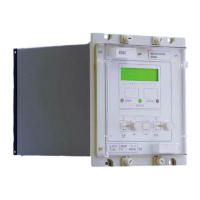VCG202/EN M/H11
Technical
external voltage VT. The advantage of using the external voltage is that the tap position
will be indicated even if the transformer is de-energised.
The tap position is determined by applying Vph-ph from a VT or an external voltage to a
potential divider and determining the tap position from the output voltage which is fed to
the relay on terminals 19-20. The tap position is rounded to the nearest integer. The
voltage of each step is given as Vph-ph/Number of resistors in external potential divider
or Vexternal/Number of resistors in external potential divider depending on the method of
TPI employed. Therefore, the number of taps available TpAvail should be set to the
number of resistors in the external potential divider. The external potential divider
provided with the relay has 22 resistors for a single unit or 40 resistors with 2 units.
Additional analogue channels are used in the relay to monitor the ac voltage supply for
the step voltage calculation. The VT voltage is monitored on terminals 17-18 and the
external ac voltage supply is monitored on terminals 15-16. The relay can indicate tap
positions 1 to 40 if the more accurate VT input is used and 1 to 30 if the less accurate
external voltage input is used.
As an example of the TPI, if the VT voltage is 100 V and there are 10 taps then a voltage
of 10 V would indicate tap position 1 and 20 V tap position 2 etc. Note, if the TPI sees 0
voltage it indicates tap position 1. To make the TPI more stable there is a hysteresis of
65% for the tap change step voltage. So using the above example if the TPI voltage is
30V the tap position will be shown as 3 and the relay will not re-calculate the tap position
unless the voltage changes by 65% of the step increment i.e. > 36.5 V or < 23.5 V.
An external potential divider is used to provide a voltage to the KVGC TPI input which is
proportional to the tap position. For this purpose a 3EA22A device is available. This unit
provides a series chain of 22 x 390 ohm resistors mounted on two PCBs in a 150 mm
DIN case.
When used with the KVGC to indicate up to 22 tap positions the regulated voltage is
applied across the 22 resistor chain as shown in Figure 30 using the VT voltage. When
used with the KVGC to indicate up to 40 tap positions the regulated voltage is applied
across a 40 resistor chain in 2 potential divider units as shown in Figure 32 using the VT
voltage. Where there are less than 22 taps with one potential divider or 40 taps with two
potential dividers on the transformer the higher tap position switches are not connected.
The connection of the TPI to the KVGC202 using the VT voltage is shown in Figures 30
and 32. The connection using an external voltage is the same except the external voltage
is connected to terminals 15 -16 as well as across the resistor chain, see Figure 31.
When the tap position contacts change over after a tap change command there may be a
momentary condition when all the contacts are open which will make the TPI think the tap
changer is on the maximum tap position. The KVGC has a time setting tTAPCHANGE, 1
- 3 s (default = 1s), which should be set longer than the maximum time delay between
contacts changing position after a tap change command to prevent wrong indication.
Two relay masks are provided in the KVGC202 to indicate ‘Tap Odd’ and ‘Tap Even’ tap
positions. For master-follower schemes the taps should be on the same tap shortly after
a tap change i.e. all odd or all even tap positions. The Tap Odd and Tap Even output
contacts can be used in an external scheme to give an out of step alarm if the VRRs
indicate that the tap positions are not all odd or even values.
Two threshold settings Tp> and Tp< are applied to the tap position read. Whenever the
value of the tap position read exceeds the set threshold (Tp>) or falls below the threshold
(Tp<), the ‘Tap Limit’ output relay allocated in the Relay Mask will pick up to give the
alarm indication.
Following cycling of the auxiliary power supply to the relay the last tap position will be
retained.

